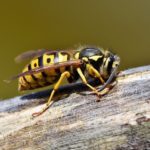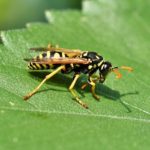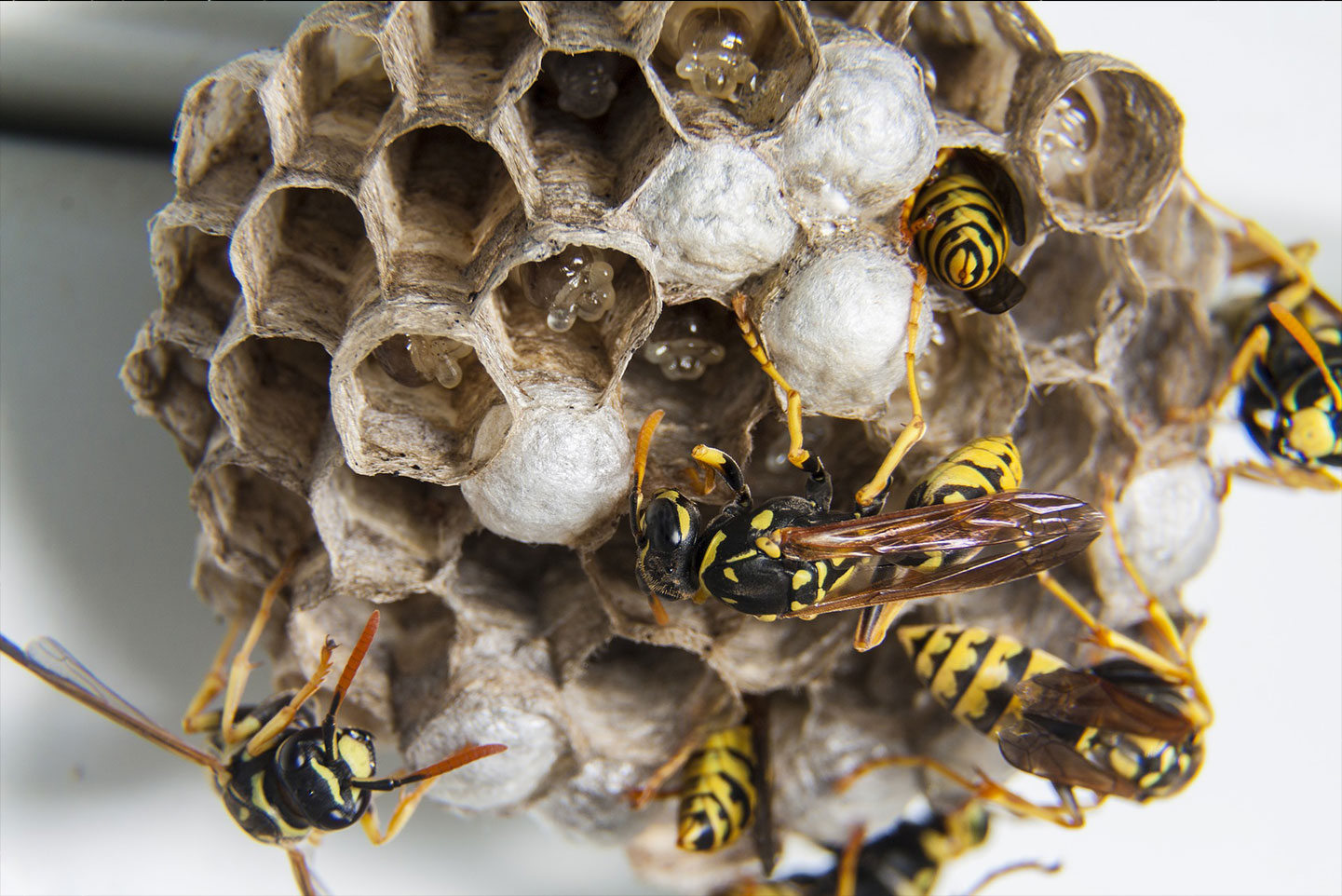(Hymenoptera Vespa)
Description
Wasps and hornets are often confused with each other, but there are some distinct differences. Wasps are small, under 1 inch long. They are black and yellow with skinny waists, although they can come in other colors such as brown, metallic blue, and bright red. They are different from bees, which are stout and hairy.
The hornet is a large social wasp that has a brown thorax with brown and yellow stripes on its body. It has a wider head and rounder abdomen. It is about 1 to 1.5 inches long.tin, which is like a shrimp shell. They can range in color from yellow to brown to red to black. They can be up to 5 inches long.

Additional Information
Habits & Behavior

Wasps and hornets are beneficial for homeowners, as they protect gardens and landscapes from pests like spiders, aphids, and caterpillars. They also pollinate blooming plants.
Wasps and hornets are focused on building nests and rearing young. They may do so in bushes, trees, and eaves of buildings.
Wasps and hornets become a problem when they are protecting their nests and babies, so try to stay away from nests. Only female wasps and hornets sting, and they do so with a modified egg-laying structure called the ovipositor.
Paper wasps are probably the most common wasps people encounter across Texas. They build paper nests typically in aerial locations and can be aggressive when disturbed.
Food
Wasps and hornets feed on sugars only. Sugars come from flower nectar, tree sap, and honeydew produced by aphids. They also like fruit and berries. They will also feed on small insects such as caterpillars and aphids. Wasp larvae produce a sugary liquid and the adults will consume that as well. Wasps can be cannibalistic, consuming other wasps.
Most adult wasps won’t consume the prey they eat. Most adult wasps will forgo protein-heavy meals and will instead reserve these food sources for the younger wasps. However, it is not uncommon for wasps to try to take a bite of meat from a BBQ, so cover your food. Wasps and hornets will eat anything sugary, including cut fruit. They may also feast on opened cans of soda, juice, or alcohol.
Reproduction
Social wasps make nests and live in large colonies. They typically mate once a year, in the fall. The queen hibernates until spring, which is when she starts laying eggs. Adult worker wasps take just 10 days to emerge from the eggs. Once hatched, they start caring for other eggs. June and July are the peak months for the nest population. Only the queen can lay eggs. Any other females that hatch are infertile.
The hornet has a similar life cycle. Once mated, queens will hibernate during the winter. They then emerge in spring to build a nest. They lay eggs that hatch into sterile female workers. Later in the summer, males and fertile females hatch. They mate and the females become next year’s queens.
Signs
Do you have wasps or hornets in or around your home? Here are some signs that you may have an infestation:
- Swarms. A wasp or hornet or two may not be too significant, but if you are seeing large numbers of them swarming around an area, there’s likely a nest nearby. Wasps and hornets often leave their nest to collect food. Follow the swarm and you should find the nest.
- Nests. Speaking of nests, that is another sign of a wasp or hornet infestation. Wasps make their nests out of mud or wood. The nests are built in the spring and get larger over time. A nest may look like a ball of paper and be as large as a basketball. Nests may have a hexagonal pattern. They may be on the side of a building or other object or they may be built underground. If small nests keep appearing on your property, you likely have an infestation and need to call an exterminator right away.
- Buzzing noises. You may be able to hear wasps and hornets before you see them. They make a buzzing sound similar to that of bees. They are especially loud when building their nests. If you hear a constant buzzing sound, there is likely a swarm of wasps or hornets nearby.
- Chewed wood. Wasps and hornets may make their nests out of wood. Therefore, you may see holes or tunnels on wood inside or outside your home. Wasps may chew on trees, logs, sticks, wood fence posts, and wood homes. If they have a large nest, they can cause a lot of damage. However, ants and termites may also chew on wood, so if you notice damage to your home, contact an exterminator for pest identification and treatment.
Dangers
Wasps and hornets are known for their painful stings. Most of these stings are mild, resulting in itching, redness, and bleeding. However, they can be more severe in nature, especially since it is possible for a person to be attacked by a swarm and stung multiple times. A person may suffer an allergic reaction or even anaphylaxis, which can lead to hives, coughing, swelling in the throat, wheezing, nausea, vomiting, difficulty breathing, and shock. Anaphylaxis needs to be treated promptly, as it can be fatal.

Wasps and hornets are very aggressive and they’re not something you want to mess with. If you see a nest, do not disturb it. Instead, call an exterminator to remove the nest safely and effectively.
Contact Us Today
Wasps and hornets are some of the most feared pests. These insects can cause painful stings and even severe allergic reactions.
The professionals at Stride Pest Control have the skills, tools, and know-how to keep both your home and business free of unwanted insects. Get quick and friendly service today by scheduling a free inspection. Fill out the online form or call (512) 777-1339 (Austin) or (210) 547-8410 (San Antonio).
Number of wasps a colony can grow to
50,000
Average days a worker wasp Lives
12-22
Average months a queen wasp lives
12
number of wasp species in the world
75,000
Get a FREE Consultation


